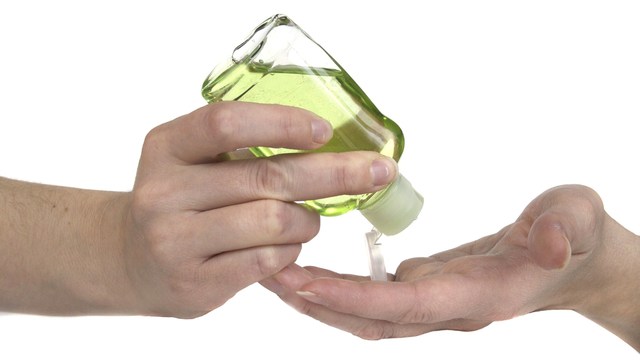 David Schliepp/PhotoSpin
David Schliepp/PhotoSpin
EmpowHER has had many questions in our very lively ASK section about hand sanitizers. With school back in session and winter approaching (sorry!), looking at the pros and cons of hand sanitizers is a good idea.
Firstly, hand sanitizer does work well. It can kill most germs with one glob on the hand, once it has been rubbed in properly. It’s handy -- most stores, gyms, schools and restaurants have it at the ready.
It can also be toted around in a tiny container in your car, purse or pocket. And it's really useful if there’s no sink nearby or you see Junior rubbing his face after licking the shopping cart.
Hand sanitizers aren’t perfect, though, and can leave germs behind.
According to the CDC, “many studies have found that sanitizers with an alcohol concentration between 60–95% are more effective at killing germs than those with a lower alcohol concentration or non-alcohol-based hand sanitizers.”
However, alcohol-based sanitizers can be very drying to the hands and the more effectiveness you want, the more alcohol is required.
Watching people use sanitizer (and I have), it’s clear many don’t use it properly. A few drops and a quick rub into part of the hand isn’t good enough.
We need to use it the same way as we use soap and water. We need to use a good amount, spending time to make sure it's all over our hands until the sanitizer has dried in.
Do most people actually do this?
Some alcohol-free sanitizers contain something called triclosan. This is an ingredient found in pesticides. Triclosan has been known to cause problems with hormones in animals and has not been found to be any better than soap and water.
When in doubt, avoid chemicals that have shown to be hazardous to animals.
There is also worry over the fact that hand sanitizers can merely reduce the amount of germs on hands and not eliminate them. Germs may come back stronger and develop an immunity to these kinds of hand cleaners.
You may have seen signs that say something along the line of “hand-washing is the single most effective way to limit the spread of germs” and this is true. What still works best is old-fashioned hand washing with lots of soap and warm water.
If there’s a choice between a sanitizer and sink, pick the sink. About two minutes should be spent washing hands thoroughly including in and around fingers and jewelry. Rinse well.
Having a small container of moisturizer is a good idea as this kind of hand washing can be drying to hands.
Hand washing with soap and warm water also takes away more germs than sanitizers, especially dangerous ones like Clostridium difficile. Not only that, but this methods takes away ingrained dirt and grime better than anything that comes out of a bottle.
All in all, hand sanitizer is a good thing to have around. It’s certainly far better than nothing and can, in fact, protect against getting the flu and other viruses or bacterial infections that are incredibly easy to pick up.
Keeping one in the car and in purses takes up very little room and can make the difference between a kid (and you!) getting sick or not.
But when possible, use that soap and water for the best possible way of ridding germs from hands -- and consequently your body.
Sources:
CDC. Centers for Disease Control and Prevention. Hand Washing : Clean Hands Save Lives. “Show Me the Science - When to Use Hand Sanitizer”. Web. Retrieved Sept 30th, 2014.
http://www.cdc.gov/handwashing/show-me-the-science-hand-sanitizer.html
CDC. Centers for Disease Control and Prevention. “Triclosan: What Consumers Should Know”. Web. Retrieved Sept 30th, 2014.
http://www.fda.gov/forconsumers/consumerupdates/ucm205999.htm
Reviewed October 7, 2014
by Michele Blacksberg RN
Edited by Jody Smith




Add a Comment2 Comments
Very informative. I must say, I don't know if I've ever spent 2 minutes washing my hands. I'll give it a try but I know my patience will run short but I will use more sanitizer each time.
January 22, 2015 - 6:01pmThis Comment
Triclosan is one of the most commonly used hand sanitizers. It is a hormone disrupter. I recently read that even the FDA is coming in on not using it.
If it is in your toothpaste, throw it out. The mouth absorbs it into the body.
Just use soap and water and wash thoroughly.
December 20, 2014 - 8:48amThis Comment